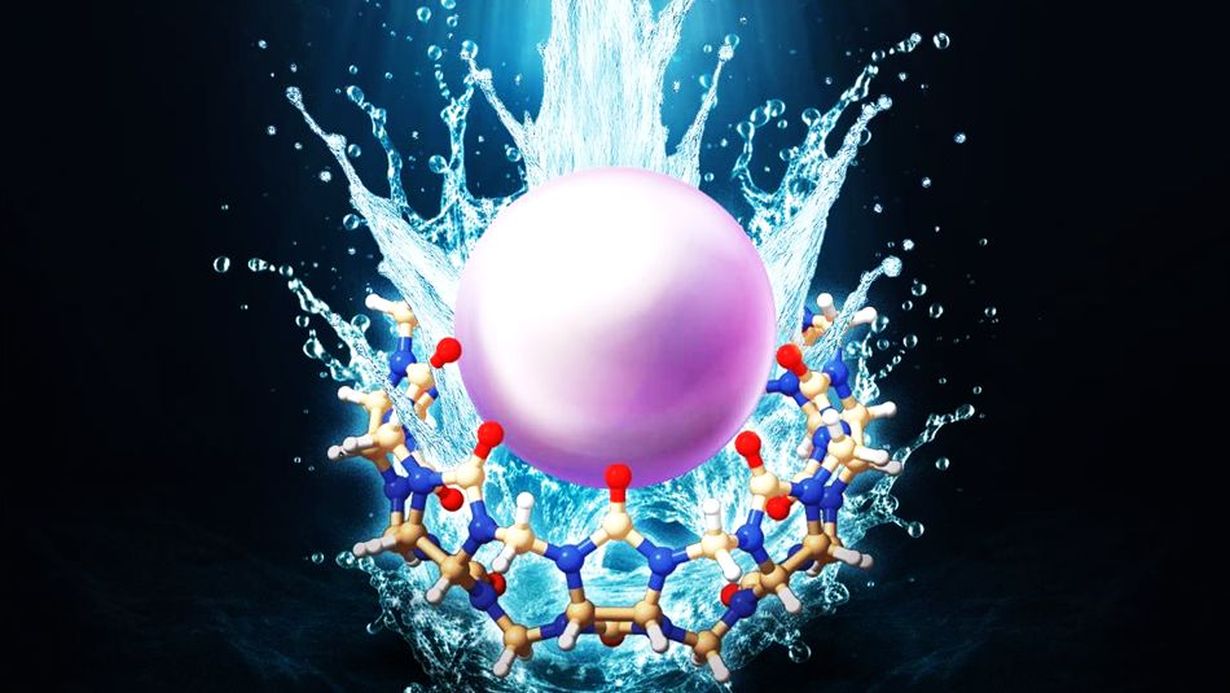
Water is everywhere - it covers the major part of Earth, circulates in the human body, and is found even in the smallest molecular clefts. However, what happens if water cannot flow freely, but is enclosed in such structures? Researchers of Karlsruhe Institute of Technology (KIT) and Constructor University in Bremen proved for the first time that enclosed water can influence its surroundings and favors binding between molecules. This discovery could open new paths for the design of drugs and new materials. The researchers report on their findings in the International Edition of the "Angewandte Chemie" journal. (DOI: 10.1002/anie.202505713 )
Part of the water on Earth exists in tiny nooks and crannies - enclosed in molecular cavities such as protein binding sites or synthetic receptors. It has been a controversial issue so far whether this water behaves neutrally in the presence of other molecules or has an influence on the binding process. "Usually, water molecules interact most strongly with each other. However, data obtained from experiment shows that water behaves unusually in such narrow cavities," says Dr. Frank Biedermann from KIT's Institute of Nanotechnology. "We now could supply the theoretical basis of these observations and prove that the water in molecular cavities is energetically activated."
The researchers term this state "highly energetic" - not because the water glows or bubbles, but because it is in a higher energy state than usual water. The fact is that highly energetic water behaves like people in an overcrowded elevator: Once the door opens, they squeeze out. Analogously, highly energetic water forces its way out of the cavity if another molecule enters and pushes the "newcomer" to the vacant place. Thus, the water's energy favors binding between the new molecule and the molecular cavity.
Findings Allow to Predict the Binding Force
The researchers used cucurbit[8]uril as the "host" molecule. It is able to receive other molecules termed "guest" molecules and, thanks to its high degree of symmetry, it can be analyzed significantly easier than complex systems such as proteins. "Depending on the guest molecule, computer models enabled us to calculate how much more binding force the highly energetic water yields," explains Professor Werner Nau from Constructor University in Bremen. "We found that the more energetically activated the water is, the better it favors binding between the guest molecule and the host when it is displaced."
Biedermann adds: "The data obtained clearly shows that the concept of highly energetic water molecules is physically founded - and that those very water molecules are a central driving force during the formation of molecular bonds. Even natural antibodies, for example against SARS-CoV-2, might owe their effectiveness partly to the way how they transport water molecules into and out of their binding cavities."
Usable for Drugs or New Materials
Biedermann's and Nau's findings might have a significant influence on medicine and materials sciences. For drug design, the identification of highly energetic water in target proteins opens the possibility to systematically design active agents in such a way that they displace this water, leverage its binding force, and thereby become more deeply anchored in the protein - which will improve the effectiveness of the drug. In materials science, the production of cavities that push out or displace such water might improve the material's sensing or storing performance.
For their study, the researchers combined high-precision calorimetry - a method for measuring the heat released or absorbed during molecular processes - with computer models created by Dr. Jeffry Setiadi and Professor Michael K. Gilson at the University of California in San Diego. (iha)
Original publication
Jeffry Setiadi, Frank Biedermann, Werner M. Nau, Michael K. Gilson: Thermodynamics of Water Displacement from Binding Sites and its Contributions to Supramolecular and Biomolecular Affinity. Angewandte Chemie International Edition, 2025. doi/10.1002/anie.202505713.
Weitere Informationen zur Arbeitsgruppe Biedermann
Being "The University in the Helmholtz Association", KIT creates and imparts knowledge for the society and the environment. It is the objective to make significant contributions to the global challenges in the fields of energy, mobility, and information. For this, about 10,000 employees cooperate in a broad range of disciplines in natural sciences, engineering sciences, economics, and the humanities and social sciences. KIT prepares its 22,800 students for responsible tasks in society, industry, and science by offering research-based study programs. Innovation efforts at KIT build a bridge between important scientific findings and their application for the benefit of society, economic prosperity, and the preservation of our natural basis of life. KIT is one of the German universities of excellence.






